
|   |

|   |
 e-mail: sunilkothari1933@gmail.com Festivals of Debadhara Sansthan and Dhwani May 27, 2018 Guru Shishya Sanman festival by Debadhara Sansthan Photos courtesy: Debadhara Sanshthan Delhi Debadhara Sansthan of Delhi presented under Guru Shishya Sanman, senior dancers and their disciples at Habitat on 12th and 13th May, featuring on first day Aloka Kanungo and her two disciples Suvra Maity and Paulomi Chakraborty in Odissi, Guru Jayarama Rao and his disciples T.Reddi Lakshmi, Aditi Gupta and Abhirami Ajith in Kuchipudi and Saswati Sen and her disciples Elisha Deep Garg and Sunny Shishodiya in Kathak. 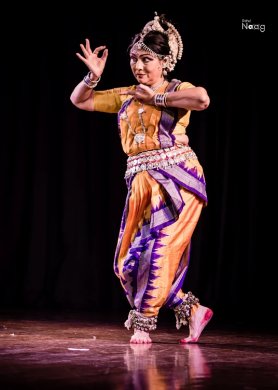 Aloka Kanungo 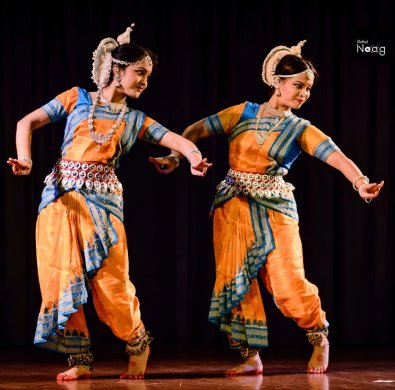 Disciples of Aloka Kanungo Aloka Kanungo from Kolkata is a senior disciple of Guru Kelucharan Mohapatra. Her personality is like that of a miniature beauty, petite but charming and with expressive abhinaya she has over the past forty years continuously expanded her repertoire with Bandha Nritya and other Odiya songs and texts. Her disciples Suvra Maity and Paulomi Chakraborty performed Talamanjari, weaving patterns like in a pallavi. Both synchronized their movements perfectly. Though if one looked for a perfect chowka, the basic pose, it seemed to have shrunk and looked narrow in terms of technique. However this seems to be a present trend and gurus have come to reconcile with it. Both included in their movements, playing upon mardala, parshva mardala, bhramari, playing manjira, and using typical suchi hasta moving in circle joyously. For abhinaya, Aloka chose a song in which Krishna teases gopis, played by her two disciples. For a change the song had Krishna being punished for his pranks. Listening to his flute when gopis were mesmerized and close their eyes, Krishna had stolen butter and when gopis asked for payment, he ran away. He promised to ferry them in a boat, but did not, so the gopis decided to punish him and tie him to a tree. He begged of them to release him but the gopis just leave him. Krishna then manages to release himself and plays flute teasing the gopis. The abhinaya by Aloka suited her personality. The music was composed by Ramahari Das and the rhythm was by Dhaneswar Swain. The disciples concluded the performance by performing Dashamahavidya with recitation of each goddess creating their iconic images of Kali, Dhumravati, Shodashi, Bhuvaneswari, Bhairavi, Baglamukhi, Chhinamasta and so on. Unlike Guru Debaprasad Das's tantric approach with demonic and benign aspects, the Mahavidyas looked less frightening. The text also was different. It was set to talamalika and ragamalika. Performed in fast tempo some of the images were effective. 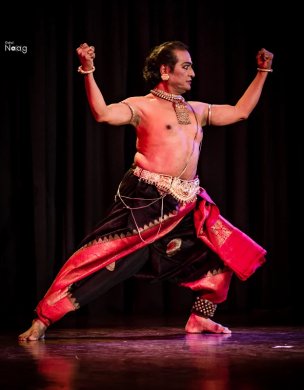 Guru Jayarama Rao 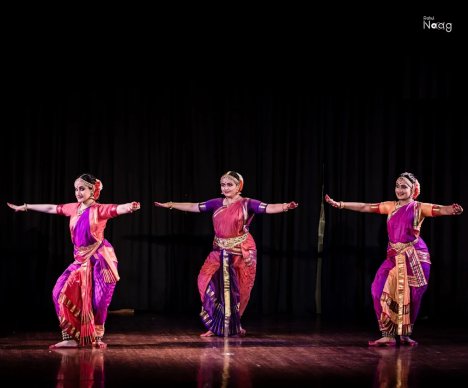 Disciples of Guru Jayarama Rao Guru Jayarama Rao excelled in Kuchipudi in his role of Hiranyakashipu in patrapravesha daru from Prahlada Charitram. Trained by traditional teachers, he displayed the valour and arrogance of Hiranyakashipu in a delectable manner, twirling his moustache, raising his two arms showing off power and sat on the throne like a royal king. His own bragging was interesting - royal crown dazzling like thousand suns, his earrings were studded with jewels, when he raised his eyebrows the Devas trembled, his subjects were entirely under his control. He proclaims: 'I am invincible' with a flourish. Jayarama Rao was in his element. The three disciples performed Vinayaka Kavuthvam in Mohana raga and danced with allure, with typical up and down movements full of lilt and grace, displaying command over technique that stood out as distinct Kuchipudi. To stanzas Tandava nritya kare Gajanana, describing Brahma keeping rhythm and other devas accompanying on different instruments when Ganesha is dancing, bowing to the son of Shiva and Gauri, they danced to the catchy rhythm in a captivating manner. However it was T.Reddi Lakshmi's abhinaya in Swati Tirunal's padam in Suddha Sarang, Aaj aye Shyam Mohan rasamandal khelane that one saw her maturity and ability to project the dramatic element of Kuchipudi with elegance and dignity. Praising Lord Padmanabha for protecting his devotees, she took for sanchari bhavas the court scene of dice game in which Draupadi is treated as a pawn. Dushasana drags her by hair and attempts to disrobe her. Lord Krishna saves her and Dushasana falls on the floor exhausted pulling endless saris. As wicked Shakuni, depressed Yudhisthir losing game, shocked Draupadi at Dushasana dragging her by hair and finally protected, she explored various emotions artistically. She has been maturing with the passage of time and is one of the gifted dancers from young generation in Kuchipudi. 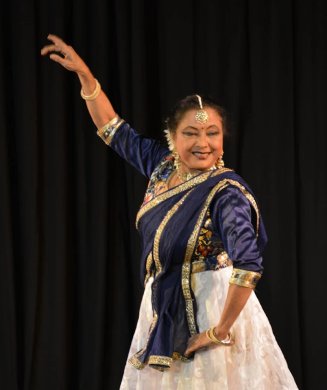 Saswati Sen 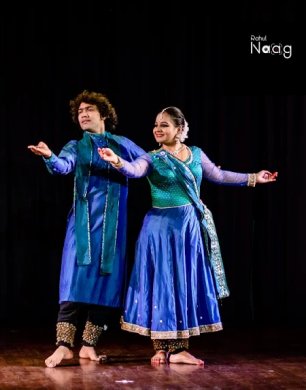 Disciples of Saswati Sen The evening was further enlightened by Kathak exponent Saswati Sen. Of late with her international engagements she has not been seen performing in India. Therefore it was a pleasure to watch her after a long time; she performed to live music with Kushal on tabla, Anirban on vocal, Imitiaz on sarangi, Rajat Prasanna on flute and for recitation of bols, her niece Ipsita Mishra, daughter of Krishna Mohan and Vasvati Mishra. Elisha and Sunny performed a duet in praise of Ardhanariswara. Versatile and well trained by both Birju Maharaj and Saswati, they depicted in Kathak how on head of Lord Shiva, Ganga is seen, how moon shines, his half body is of male and other of Parvati, and what adorns body of Parvati and what adorns Shiva's body. Parvati has hair ornaments, Shiva has Ganga in his matted locks and around neck serpents, Parvati wears silken clothes and Lord Shiva wears tiger skin. Shiva holds damaru in hand. Parvati's beauty is incomparable with precious necklace of pearls. The poem was written by Birju Maharaj in a traditional form. Both the dancers displayed high level of technique. Saswati chose Vakra Vasant tala of nine and half matras and regaled the audience with several intra forms like tode, tukde, parmelu, ginati and coming to sam perfectly. Though it was perhaps tough for lay person, it was a delight for the cognoscenti. Birju Maharaj had recently composed the parmelu in Vakra Vasant tala which Saswati executed perfectly. She turned to Teen Taal and explained how abhinaya is conveyed through movements, though it is nritta. To come on sam is like gopis in search of Krishna. One interesting improvisation she showed was a dialogue between a Sardarji and a young Japanese maiden. Counting the matras Saradarji would say 'Hoye' and Japanese would respond gently saying 'Hi'. Saswati made the performance entertaining with humour. While concluding the program she enacted abhinaya to Nazarpiya's thumri which vocalist Ajay Chakravarty has sung - Aaj mori kalai murak gayi (my delicate wrist was twisted) and the nayika in the state of mugdha, agyat youvana, with subtle expressions of annoyance when her beloved held her hand and being shy she attempted to release it, then complaining that it hurts. As mature nayika begging the beloved not to pull her braid, pallu of sari and leave her wrist, she displayed appropriate emotions wearing expressions of fake annoyance, and delight at the meeting her beloved. Saswati is extremely fortunate to study under Birju Maharaj and has danced with him for many years. Her knowledge of the art as gained from Birju Maharaj is awesome. The first day's performances ended on a highly aesthetic and pleasant note. 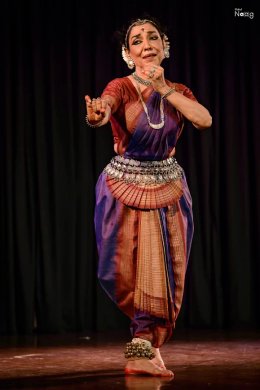 Madhavi Mudgal 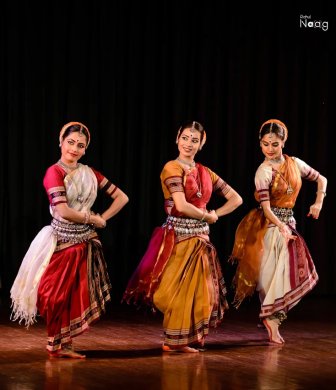 Disciples of Madhavi Mudgal On 2nd day, the artists were Madhavi Mudgal and her three disciples Shalakha Rai, Shobha Bist, and Dipika Bisht in Odissi. Madhavi began with a specially choreographed number by her, based on a poem of the noted Odiya poet Mayadhar Mansingh. The nayika is reminded of dance of Shiva Nataraja watching clouds in the sky, the peacock dancing in the Varsha ritu, spreading his feathers to the tala produced by sounds of clouds. The imagery was drawn for the season and further developed using various dance patterns in Odissi. Madhavi is a veteran dancer and performed with certain authority with perfect understanding of the text and dance vocabulary. In another abhinaya number set to Rasamanjari raga by Gopalchandra Panda, the Odiya pada was similar in concept of Gita Govinda ashtapadi Sakhi he keshi mathanamudaram. The nayika tells her sakhi that she is overcome by shyness to tell of her meeting with her beloved. She had gone after placing flowers in her braid, her bangles were in order and from somewhere she heard the melodious sound of the flute. 'I do not know where he came from and put his palms on my eyes and embraced me. I was overwhelmed at his gesture and in ecstasy.' The subtle expressions of shyness and inexplicable joy were mirrored by Madhavi as a seasoned artist. The three young disciples performed Pallavi for which the music was specially composed by Madhup Mudgal in Ragamalika. Of the same height, they danced the choreography by Madhavi with perfect synchronization. Drawing different patterns in nritta, in between they enacted putting on ornaments and took bhramaris creating the visuals with alignment. The playing on various instruments, flute, cymbals, veena and mardala were interwoven artistically. Holding suchi mudra towards head, they took turns and moved diagonally in synch with rhythm. Their chowka was perfect and slight jumps were performed with quicksilver movements. With the recitation of the bols and dancing in quick tempo reminiscent of Moksha, they concluded the number highlighting the choreography investing it with grace and sculptural beauty. 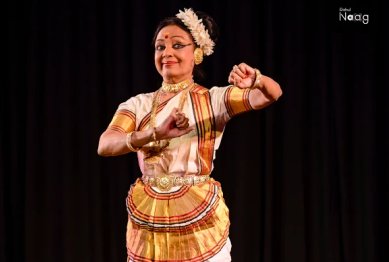 Bharati Shivaji 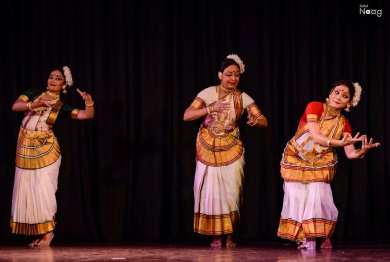 Disciples of Bharati Shivaji Bharati Shivaji and her two disciples Vani Bhalla Pahwa and Samrita Menon in Mohiniattam began with Mukhajalam nritta item set to Sopanam music in Ragamalika. The graceful typical movements of Mohiniattam with upper torso moving round the waist and the hands taking avartanas were noteworthy. With the feet, they drew arc on the floor placing their hand on the waist. Bharati is known for choreographing Gita Govinda ashtapadis in Sopanam style of music in Mohiniattam. She selected ashtapadi Dhira samire Yamuna tire in Kedar Gaula raga, taking all the stanzas of the ashtapadi. As sakhi, Bharati addressed Radha performed by Vani Bhalla Pahwa, not to sulk and not to delay meeting Krishna. Describing Krishna waiting for her on banks of Jamuna in a bower, preparing a bed of flowers and looking for Radha, the sakhi pleaded to her to get up and go. 'Leave aside you ankle bells which announce your passion for Krishna, put on blue sari and proceed, O lovely Radha.' For patati patatre, the leaves falling on the ground awakening Krishna to believe that Radha must have come, the abhinaya of flying bird, sitting on a branch and leaves falling on floor was performed delicately. Radha sitting on the floor and not getting up to go annoyed the sakhi and she with mukhajabhinaya wearing expressions of annoyance pushed Radha to go to the bower. There was interlude of nritta, both dancing together and singing of solfa bols. It embellished the movements. Radha is ready to go and yet hesitant, so the sakhi pushes her and sees that Radha is moving forward. The distance between Radha and the sakhi was conveyed well as the sakhi moved to the end of the stage looking in the direction that Radha is moving. 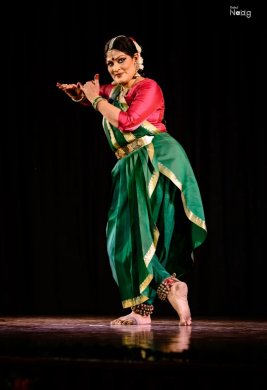 Geeta Chandran 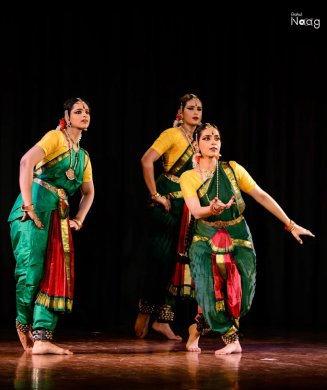 Disciples of Geeta Chandran The finale by Geeta Chandran and her Natya Vriksha dancers was Vanajaksha varnam in Bihag raga. Krishna was performed by Geeta and the roles of gopis were performed by Radika, Amrita and Madhura. I had seen the varnam in a solo format at Shimla Dance Festival and enjoyed it immensely. Geeta using her choreographic skills embellished the varnam with suggestive sancharis. The incomparable beauty of Krishna, his lotus like eyes described by gopis one after another from different angles, Geeta as Krishna standing in one corner of the stage, Vrindavan was created in a trice. The alternating nritta passages were dazzling. Indra gets upset when he sees the cowherds and gopis praying to Krishna, so he sends heavy rains, but Krishna lifting the mount Govardhana saves them. The sanchari of Kaliyadaman, with game of ball, its falling into the river Yamuna and Krishna's plunging into water and subjugating Kaliya was enacted dramatically. When Vishnu in incarnation of a dwarf, Vaman, asked Bali raja where to put the third step, and he bowed his head, Vishnu placing his foot on his head pushed him to patala below the earth. This episode found graphic description in dance vocabulary. Describing Krishna's charms as Venudhara, Gopis playing Rasalila with him, the festive joyous mood, led all to be with Krishna. The poet's other similes for Krishna's gait similar to an elephant, his crown adorned with peacock feather, addresses him as Kotisundara, surpassing even beauty of millions of Kamadeva. Sung in melodious raga the varnam stood out for its complexity, performed by the dancers with commendable command over the technique. Their joyous dancing and excellent expressions were a treat. Binayak Panda deserves congratulations for mounting such an engaging two day festival of the senior dancers along with their young disciples and showcasing them in intimate IIC auditorium. Dhwani's annual dance and music festival Photos: Inni Singh Vaswati Mishra is a disciple of Pandit Birju Maharaj. Wife of Krishna Mohan, son of legendary Pandit Shambhu Maharaj, she has been active on the Kathak scene in the capital for more than 40 years. Younger sister of Saswati Sen, she represents Lucknow gharana. Vaswati's Kathak exudes the khubsoorati, the beauty and nazakat, the delicacy of the gharana. Besides being a solo dancer, she is known for her choreographic works. Her role of Sita in Birju Maharaj's Katha Raghunath Ki is still remembered by her admirers. As a director of Dhwani, she has created several choreographic works, collaborating with outstanding musicians including sarod maestro Ustad Amjad Ali Khan. Noteworthy compositions include works of Dr. Harivansh Rai Bachhchan. Rare rhythms in collaboration with Shivamani, Selva Ganesh and Taufique Qureshi, son of Allarakha Khan, are the feathers in her cap. A dance choreographic work Pinocchio penned by Gulzar and set to music by Zakir Hussain is another major work. Recently she worked with Parvathy Baul for a work titled Raha. She established Pandit Shambhu Maharaj Kathak Academy in memory of her father-in law in 1999 and has been imparting training to several students. She also has a special knack of choreographing group works for children.
Recently she mounted an ambitious work involving more than 70 students from tiny tots to the age of 18 titled Taatil. It is a Turkish word for holiday. Fun and play time are both synonymous with the word vacation. So when the curtain is raised at Kamani Auditorium to the overflowing audience, one saw on stage a colourful gazebo erected on two pillars decorated with flowers and on side, a way to come down the steps. Some twenty tiny tots and young dancers ran through the stage, formed a line holding hands and executed footwork in perfect rhythm. Two young children sitting back to back are absorbed in watching their mobiles, ignoring some children requesting them to join for games. A real pity, said the other children, and happily dancing ran across stage into the wings. Several games were shown danced in Kathak, the most interesting one being basketball. The girls play ball in tala, never once dropping it. The perfect footwork and synchronizing earned them a spontaneous round of applause. Coming to contemporary games, playing with Yo Yo, ring round the waist followed by the game of hututu, they made seniors in the audience feel nostalgic for the games they played when young. A young girl maybe five sits sulking reading a book. Her elders ask her to join her friends, sing and dance. On the upper stage two older girls are busy with their computers not joining the others. Children dressed in guise of butterflies fill up the stage. Others move as if they are flying. The interesting visuals were of children acting as various coloured fish swimming across the stage turning it into a large aquarium. One young girl watching from the top of the gazebo wants to come down and join them. The world of fantasy was magical. What was remarkable was the coordination of these children in various age groups. This was performed for more than forty minutes, but not once the interest was flagged. Hats off to Vaswati for visualizing and choreographing Taatil with such rhythm, colour and fun. The second half was Dwani's production The Hero in Shades. It is an autobiographical piece of a priestess in a temple who is a devotee of Krishna. She loves him as a god but is also besotted with his activities which are contradictory. Flashback to Mahabharata, the opening scene starts with a shloka which announces of death of Krishna at the hunter's arrow in a forest after the annihilation of Yadu vamsha. Gandhari's curse resonates. The auditorium is filled with the signals of war; the music included the call of war, drums, long drones, clashing of swords, armies march; on the back drop with a white net dancers run across the war field, in front two male dancers and four female dancers perform collectively as warriors and the scene of war is created. Dancers perform tatkar, take chakkars, and holding reins of horses march on.
The commentary narrates the incongruity and flashback depicting the death of Jayadrath, creating darkness covering the sun. But creating darkness to mislead Jayadrath rankles. Bhishma was killed by placing Shikhandi in front. Bhishma had wowed that he will not attack woman, and Krishna asks Arjuna to shoot arrow and kill Bhishma. Similarly when the wheel of Karna's chariot gets stuck in the earth Krishna against all norms of war, tells Arjuna to kill Karna. Dronacharya commits suicide when false news of death of Ashwathama is announced. Krishna had promised not to take weapons in his hand but wielded Sudarshan Chakra to hide sun so it seems darkness has descended to cause Jayadrath's death. So many conflicting actions on part of hero Krishna. And yet Krishna is the charmer, plays flute to entice gopis and plays Rasalila. Some important events from Krishna's life were depicted. The priestess in the temple recalls Mirabai's songs, how she moved in public singing his praises and danced. But the priestess is confused. She wants to know what is nyaya and anyaya (just and unjust), situated in 20th century, with flashbacks from the past where controversies are singled out but left unresolved drawing audience to ponder over it. Led by male dancers Daniel Freddy and Madhav, and female by Saswati's daughter Ipsita Mishra and other dancers the group performs various events to raise the shades in which the hero is found. Their training is excellent and they all perform enhancing the issue raised. In the end, certificates were given to students. Their generation showed the love for classical Kathak.  Dr. Sunil Kothari is a dance historian, scholar, author and critic, Padma Shri awardee and fellow, Sangeet Natak Akademi. Dance Critics' Association, New York, has honoured him with Lifetime Achievement award. Post your comments Please provide your name and email id when you use the Anonymous profile in the blog to post a comment. All appropriate comments posted with name & email id in the blog will also be featured in the site. |